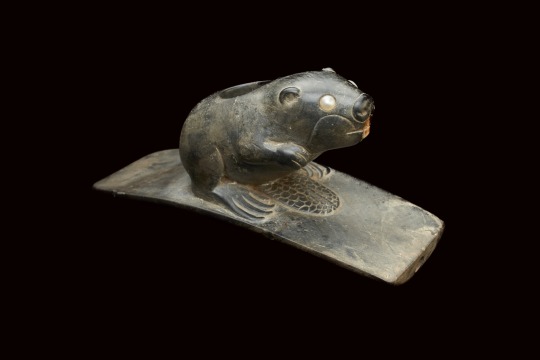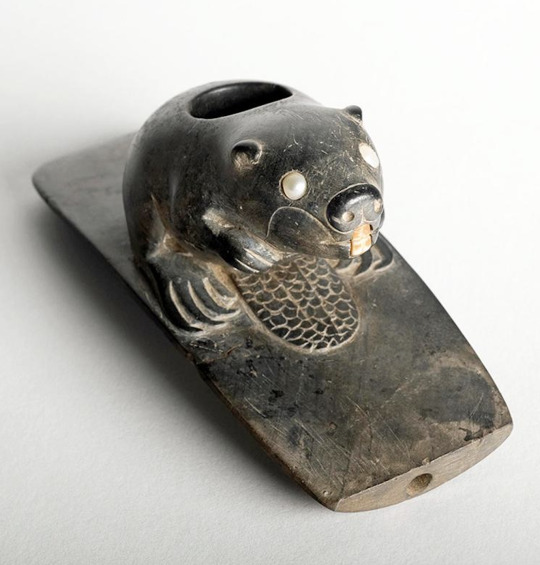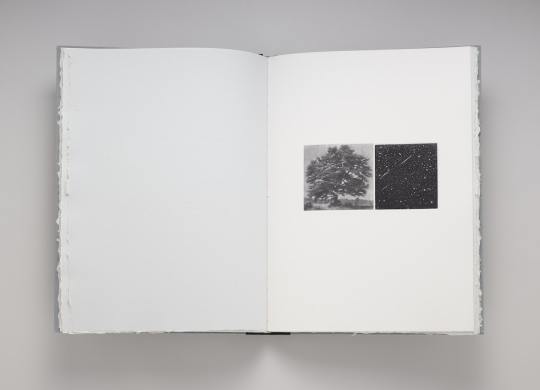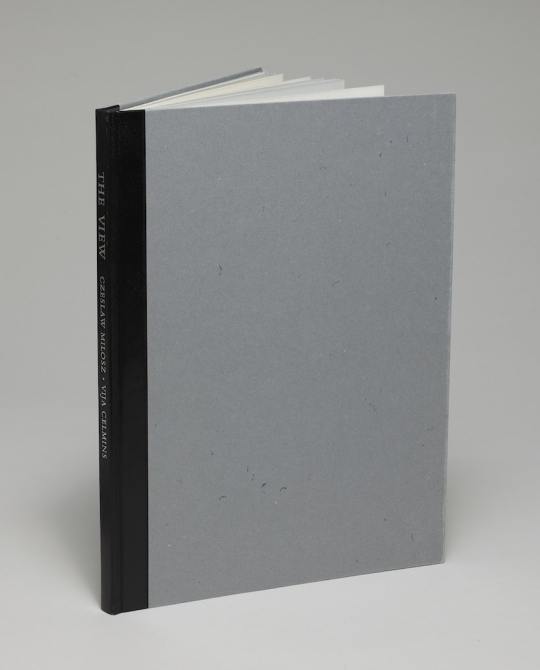#Hopewell Museum
Text



Beaver Effigy Pipe (circa A.D. 200-400)
Pipestone with mother of pearl and bone inlay. Hopewell Culture, from Tremper Mound in Scioto County, Ohio.
via. Gilcrease Museum, Tulsa
#archaeology#hopewell culture#indigenous art#pipestone#other(s') art#<- new tag alert (going to be mainly for art history posting)
40 notes
·
View notes
Text

Czesław Miłosz, The View, Mezzotints by Vija Celmins, The Library Fellows of the Whitney Museum of American Art, New York, NY, 1985 [Walker Art Center, Minneapolis, MN. © Vija Celmins, Czesław Miłosz]

Printer: Doris Simmelink, Los Angeles, CA
Binder: George Wieck (Moroquain Bindery, Hopewell Junction, NY)
#graphic design#art#drawing#mezzotint#poetry#book#cover#book cover#czesław miłosz#vija celmins#doris simmelink#george wieck#moroquain bindery#whitney museum of american art#walker art center#1980s
38 notes
·
View notes
Text
Bibliography (Reference style)
Baudot, B. (2004). Meaning of Life and Purpose of Society: Essential Dimensions of Morality – Report. Triglav Circle. https://www.triglavcircleonline.org/meaning-of-life-and-purpose-of-society-essential-dimensions-of-morality/
Broken Pencil. (2023, September 19). Catalina Cheng on Ceramics and Preservation of Queer Art History . https://brokenpencil.com/folio-2/folio-catalina-cheng-on-ceramics-and-preservation-of-queer-art-history/
Camus, A., & O’Brien, J. (2018). The myth of Sisyphus (Second Vintage international edition). New York: Vintage International : Vintage Books, a division of Penguin Random House LLC.
Freschi, F., Venis, J., Nazier, F., Russell, K. J., Hopewell, H., Carter, L., Miller, S. C., Krishnan, T., McCaw, C., Galloway, M., Wilson, J. K. T., & Campbell, D. (Eds.). (2021). The politics of design: Privilege and prejudice in aotearoa new zealand, australia and south africa. Otago Polytechnic Press.
Jessica, Z. (2023). Combing. Best Awards. https://bestawards.co.nz/spatial/student-academic-spatial/aut-art-design/combing/
Robèrt, K.-H. (2008). The natural step story: Seeding a quiet revolution. Gabriola Island, BC: New Catalyst Books.
Sartre, J.-P. (2003). Being and nothingness (H. E. Barnes, Trans.; 2nd ed.). Routledge.
Sun, Y., & Peng, Y. (2016). Can’t help myself. The Guggenheim Museums and Foundation. https://www.guggenheim.org/artwork/34812
The Cooperative Human. (2018). Nature Human Behaviour, 2(7), 427–428. https://doi.org/10.1038/s41562-018-0389-1
Tuhiwai Smith, P. L. (2012). Decolonizing Methodologies: Research and Indigenous Peoples. Zed Books.
http://ebookcentral.proquest.com/lib/aut/detail.action?docID=1426837
Weir, P. (1989). Dead Poets Society. Buena Vista Pictures Distribution.
Wunderlich, F. M. (2013). Place-Temporality and Urban Place-Rhythms in Urban Analysis and Design: An Aesthetic Akin to Music.
Journal of Urban Design, 18(3), 383–408. https://doi.org/10.1080/13574809.2013.772882
0 notes
Text

Tourists walk the beach at low tide at Hopewell Rocks in New Brunswick, Canada. The shoreline is on the Bay of Fundy, where the world’s highest tides regularly turn up fossils. Photograph By Eric Carr, Alamy
Anyone Can Discover a Fossil on This Beach—If You Wait Out the Tides
In New Brunswick, the world’s highest tides reveal fantastic fossils, from giant dragonflies to dinosaur footprints.
— By Robin Catalano | February 27, 2023
If you want to see where dinosaurs walked and giant, ancient centipedes crawled, just follow their footprints. That’s what scientists are doing in New Brunswick, Canada, where the world’s highest tides rush and recede over 40 feet twice per day in the Bay of Fundy. Amid rugged foothills and rock cliffs along the Atlantic Ocean, this phenomenon is revealing one of North America’s richest caches of fossils.
While researchers make most of the discoveries in this less visited province, citizen scientists—students, local residents, and even visitors—have been involved in a number of significant finds. It’s a welcome assist in a place where a piece of the ancient history puzzle might vanish as quickly as it emerges.
“It’s a race against the tides,” says Matt Stimson, a geology and paleontology curator at the New Brunswick Museum in Saint John, the province’s largest city. “Mother Nature is doing the excavation work for us. Something new is continually exposed. But it can also be erased.”
Here’s how travelers can see fossils—and help find new ones.

A Rich Fossil Record
Scientists have recognized New Brunswick’s paleontological abundance since the 1840s, when coal mining revealed fossilized flora and fauna. Over the Earth’s three evolutionary eras, the region has been a volcanic incubator of invertebrate life; an oxygen-rich, biodiverse rain forest that gave rise to dinosaurs; and a tundra dominated by furry, roving giants like mastodons.

Ancient ferns are preserved in rock that washes up on the shores in the Bay of Fundy. The 170-mile-long basin in New Brunswick and Nova Scotia has one of the richest caches of fossils in the Western Hemisphere. Photograph By Kitchin and Hurst , All Canada Photos/Alamy
Significant recent discoveries include invertebrate and vertebrate tracks trapped in stone along the beaches of the Atlantic coast. “When we stopped looking just for bones, the discoveries were eye-opening,” Stimson says. “An animal can only leave one body or skeleton, but thousands of footprints.”
New Brunswick Museum research associate Olivia King has made several notable finds over the past three years. They include the jaw of a proto-reptile about the size of a salamander and the tracks of the continent’s earliest, possibly tiniest, dinosaur (about two inches long).
“Until recently, people thought all the important fossils were being found in Nova Scotia,” she says of the province southeast of New Brunswick on the Bay of Fundy. Nova Scotia is sometimes called the “coal age Galapagos” due to its fossilized trees, trilobites, and early reptiles from the Carboniferous Period (about 359 to 299 million years ago). “But what we’re finding in New Brunswick is equivalent to or older than sites in Nova Scotia,” says King.
Citizen scientists have turned up many recent finds. Two local college students, Luke Allen and Rowan Norrad, uncovered hundreds of artifacts over the last few years. They include the wing imprint of a previously unknown falcon-sized dragonfly and amphibian footprints dating to Romer’s Gap, a largely undocumented break in the tetrapod (four-limbed animal) fossil record.
How To Go Fossil Hunting
Travelers can dip into New Brunswick’s fossil history at parks and preserves up and down the province’s 1,400-mile-long coastline. Tour guides lead walking, hiking, and paddling excursions. There’s also beachcombing at low tide, when the water recedes as much as 650 feet and you can walk along the gurgling mudflats of the ocean floor.
You can also go fossil spotting on your own, but consult a tide chart for safety; you have about six hours between the water’s lowest and highest points. Once the tide begins to roll in, it rises a foot every six minutes, and can easily overwhelm a beach in less than an hour.
Some fossil footprints—stuttering zigzags of toe and tail-drag impressions—are found embedded in cliffs; others turn up in rocks the tides scatter across the sand. By provincial law, discoveries must be left in place—like crime scene evidence—and reported to the New Brunswick Museum, which then deploys researchers to evaluate them. If the find is significant, you might see your name recorded in the museum.
To experience the ancient side of New Brunswick, base yourself in Saint John, part of the UNESCO Stonehammer Geopark. Start at the New Brunswick Museum, where more than 23,000 fossils include a juvenile mastodon that perished about 80,000 years ago.
Head 30 miles east to the UNESCO Fundy Biosphere Region, more than a million acres of rugged woodland and craggy coastline stretching from the village of Saint Martins nearly to the Nova Scotia border. Along the biosphere’s beaches, there’s fossil hunting when the waves slurp out.

Fishing boats sit on the beach during low tide in the Bay of Fundy. Photograph By Robbie George, National Geographic Image Collection
About an hour-and-thirty-minute drive north, the otherworldly red sandstone cliffs of Dennis Beach and neighboring Waterside Beach have revealed ancient tetrapod and proto-dinosaur footprints. Visitors can go tide pooling here to see tunicates or sea squirts.
Sixty-five miles northeast of Saint John, Cape Enrage gets its name from the turbulent waters that churn over its reef at low tide. The six-acre provincial park offers rappelling, zip-lining, and beach fossil tours where you can spot ferns and large, bamboo-like Calamites.
Hopewell Rocks, New Brunswick’s marquee attraction, is about 20 miles northeast of Cape Enrage. It holds the province’s largest concentration of sea stacks, free-standing rock formations whittled out of the coastline during the last ice age. A limestone ledge along the far end of the beach preserves 340-million-year-old stromatolites, blue-green algae masses that range from the size of a grapefruit to the height of a toddler.
0 notes
Text
Medal mystery: First World War medal found in empty lot
Stephen Kellar made the discovery of a lifetime on Saturday -- and then gave it away.
Using his metal detector, the Moncton man located what he thought was some sort of military medal six inches underground in a vacant downtown lot.
He eventually found out it was the Silver Memorial Cross from the youngest New Brunswick soldier killed during active duty in the First World War.
Pte. Clifford Robinson Oulton of Brigedale -- what is now Riverview – stood five-foot-four-and-a-half and weighed 120 pounds when he joined the army in 1916. He was 14-years-old, but claimed to be 18.
Oulton was killed at Passchendaele, one of Canada's bloodiest battles, on Nov. 1, 1917, at the age of 15.
Kellar was moved when he heard about Oulton.
"The boy has a very sad story. He was 14, 15-years-old. He lied about his age to get into the military. He died for the cause he was fighting for. My heart goes out to him," said Kellar.
Kellar discovered what he had in his possession through a metal detecting Facebook group and then decided to reach out to the Albert County Museum in Hopewell Cape to see if they wanted it.
"Yes, we want this," said Stuart Liptay, the past president of the Albert County Historical Society. "This is a huge piece of our history. It's a huge piece of Albert County's history and New Brunswick history. Just the significance alone, the Silver Cross is the medal that was given to his mother."
The Memorial Cross, more commonly known as the Silver Cross, was a memento of personal loss and sacrifice on the part of widows and mothers of Canadian soldiers killed during the First World War.
How it ended up in an empty lot on Atlantic Avenue is a mystery.
"You have to wonder how this ended up six inches underground," wondered Liptay. "Did she bury it? Did she move? Did she lose it carrying it around one day in the garden? Was it lost in a wall and the house was torn down? Who knows?"
Oulton had four sisters, but there are no known descendants of him in the Greater Moncton area.
The Silver Memorial Cross can be found online from anywhere between $300 to $700 according to Liptay, but thanks to Kellar's generosity, it will remain at the museum.
"This is the youngest New Brunswicker killed in active service in the First World War, basically, probably in any war. To find this just before Remembrance Day is really significant. The significance is beyond measure for New Brunswick and Canada really," said Liptay.
Kellar has been discovering old coins and other metal objects around Moncton for about five years. He said he loves the hobby and plans to continue searching for items.
So, does Kellar consider himself a historian?
"I do now," laughed Keller. "I feel good about it because now I'm going to be keeping my eye out for a little more than just the one relic. If I do find something else, I'm definitely going to donate it to the Albert County Museum."
from CTV News - Atlantic https://ift.tt/1srJ9VR
0 notes
Text
Good-bye to New Mexico and a Quick Stop in Colorado - Littleton, CO

On the 11th, I packed up and headed to where I was scheduled to pick up the guys. I met them on Highway 64, near Hopewell Lake. The wind was blowing so hard that the guys had to go inside the trailer to wash up. Once everyone was washed up and in a clean set of clothing, we made the long drive up to our friends’ place in Littleton for a zero-day. We enjoyed a lovely evening on the Mogard’s back patio - Roger and Kathy put out quite a spread for the guys on our first night there. Doug and Tom spent the zero-day getting ready to get back on the trail. Bob had made the decision to get off the trail and return to California, he spent the day making arrangements to get back home. Kathy and I took a nice walk around Ketring Lake and then had lunch at Damascus Grill - it was a lovely “zero-day” for me!

One of my favorite views at Ketring Lake.

Littleton Historical Museum from the walking path around Ketring Park.

Enjoying a brew or two at Breckenridge Brewery with the gang.
Our second night in town, we ordered take-out from Romano’s (one of our favorite restaurants when we lived in Littleton). Our son, Dan, joined us for the evening. Bob, enjoyed his last night with TOUGH+ - we think he was a bit suprised by the size of the calzone he ordered:

We all had a good laugh about that! It was gigantic.

Another great stay at the Mogards! Tomorrow we head to Rawlins, back to the grind! Thank you, Kathy and Roger, for your wonderful hospitality!
0 notes